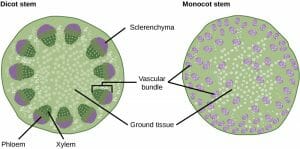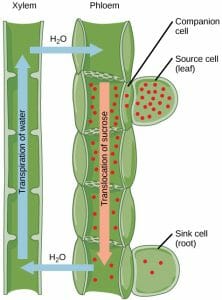Vascular Tissue Definition
Vascular tissue is an arrangement of multiple cell types in vascular plants which allows for the transport of water, minerals, and products of photosynthesis to be transported throughout the plant. Non-vascular plants, such as some algae and moss, do not have vascular tissue and therefore cannot easily transport water and nutrients. Vascular plants use their vascular tissue to transport water and nutrients to great heights, able to feed the tops of trees hundreds of feet high.
Types of Vascular Tissue
Xylem
Xylem is a specialized type of vascular tissue created in vascular plants to transport water and nutrients from the roots of a plant to the tips of the leaves. Every cell in the plant needs water and minerals to survive, and complete necessary reactions. The xylem is created from hollow, dead cells. Water is absorbed into the roots, which creates a positive pressure on the water inside the column. As water evaporates out of the leaves, the process of transpiration pulls water into the leaves. In this way, the xylem serves as a straw, allowing water to carry minerals upwards through the plant.
Phloem
At the same time, the plant is producing sugars via photosynthesis, which must be transported downwards, to the stem and root cells. Another vascular tissue, the phloem, accounts for this process. Unlike the xylem, this vascular tissue is made up of living cells. The so-called sieve cells are connected via a thin membrane called the sieve plate. Through this channel of phloem cells sugar is transported throughout the plant. Unlike water, sugar is thick and sappy. The phloem requires inputs of water from the xylem and specialized proteins to help quickly pass the sugars through the plant.
Structure of Vascular Tissue
In different species of plants, vascular tissue is arranged differently. Typically, the cells are long, narrow, and tubular. The vascular tissue is also often arranged into bundles within the stem or leaf. Below is a comparison of the vascular tissue found in monocot and dicot plants.
As you can see, the vascular bundles in dicots are much larger and more consistently arranged. Monocot species, on the other hand, spread the xylem and phloem of the vascular tissue around throughout the stem. These two methods reflect the structure of the plants themselves. Monocots tend to be plants like grasses, which have veins and leaves which run in parallel. In dicots, such as many flowering trees and fruiting plants, the leaves and veins in the leaves branch off in various patterns. This organization favors a vascular tissue which is more organized, and can branch as the plant grows.
In woody dicots, the vascular tissue is even more organized, with a vascular cambium layer producing xylem on the inside and phloem on the outside. These layers are produced seasonally, which give woody plants their characteristic “rings”. By adding to the vascular tissue every season, these plants can handle an increase in growth and become very large. Some monocots such as palms have adopted a secondary growth technique while maintaining a scattered arrangement of vascular tissue.
Functions of Vascular Tissue
Vascular tissue functions mainly in maintaining the water balance and sugar balance of a plant. Not only does the plant’s cells need water to complete basic biological functions, they also need the minerals and nutrients found in the soil to complete their work. Most plants have small pores in the leaves called stoma, which allow water to evaporate and gases to exchange. To get more water and nutrients into the cells of leaves, these small pores open.
As the water evaporates, the forces of adhesion and cohesion pull the water up the tubes of the xylem. As water is absorbed through the roots, this also creates a pressure from the bottom to force the water upward. The tubes of the xylem are narrow to support this action, but there are many of them bundled together. The xylem portion of the vascular tissue can be seen below, on the left.
As the water moves up and into the leaves, some of it is needed to dissolve the sugars created by photosynthesis and carry them back down the plant. Remember that photosynthesis creates glucose, which the plant will use as energy. The plant combines glucose molecules to create sucrose, a temporary storage sugar. The root cells, and other cells in the stems and leaves, do not create their own glucose and rely on the plant to provide them energy. The phloem cells work to transport this created energy all throughout the plant from source cells, like leaves, to sink cells, such as those in the roots. The vascular tissue is also responsible for controlling the flow of nutrients when the plant is creating flowers and fruits, which drastically affects the process.
Farmers have learned to manipulate the vascular system of plants in various ways to modify their crops in various ways. For instance, by damaging the vascular tissue below a fruit on a branch, the sugars will be translocated to the fruit. While the roots may suffer, the fruit will become much larger as a result. This is called girdling, and is one of many techniques used to alter the flow of nutrients within a plant by modifying the vascular tissue.
Quiz
1. Which of the following is NOT a vascular tissue?
A. Xylem
B. Phloem
C. Meristem
2. Why is phloem made of living cells, while xylem is made of dead cells?
A. No reason
B. Phloem is involved in active transport, Xylem is not
C. Phloem is a newer tissue, Xylem has simply died
3. Why can vascular plants be much taller than non-vascular plants?
A. They can transfer nutrients higher
B. They need less water
C. They need less sunlight
References
- Hartwell, L. H., Hood, L., Goldberg, M. L., Reynolds, A. E., & Silver, L. M. (2011). Genetics: From Genes to Genomes. Boston: McGraw Hill.
- McMahon, M. J., Kofranek, A. M., & Rubatzky, V. E. (2011). Plant Science: Growth, Development, and Utilization of Cultivated Plants (5th ed.). Boston: Prentince Hall.
- Nelson, D. L., & Cox, M. M. (2008). Principles of Biochemistry. New York: W.H. Freeman and Company.


